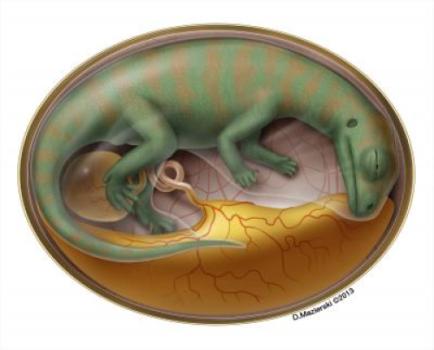Scientists from several countries around the world led by a University of Toronto researcher also compared embryos at different stages of development found in an area of one square meter in southern China

The period of prosperity of the dinosaur embryos found in the Lufeng region of southern China is ancient by any standard. So far, almost all dinosaur embryos have been dated to the Cretaceous era. The Cretaceous ended 125 million years after the bones discovered at the Lufeng site were buried and fossilized.
An international group of researchers from Canada, Taiwan, China, Australia and Germany, led by paleontologist Robert Rice from the University of Toronto, analyzed over 200 bones of different dinosaur embryos at different stages of development.
"We are opening a new window into the lives of the dinosaurs," says Reyes. "This is the first time we can follow the development of the embryos. Our findings will have implications for the biology of these animals."
The bones sampled are from ten different embryos of the sauropodomorph dinosaur Lufengosaurus, the most common dinosaur in this area at the beginning of the Jurassic period. An adult Lupangosaurus reached a length of eight meters.
The bone contents most likely came from several nests that contained dinosaurs at different embryonic stages, and thus they gave Rice and his team a rare opportunity to study dinosaur growth patterns. The dinosaur embryos are often found in single nests or nests that have not been preserved in their entirety that allow a glimpse of one embryonic stage.
To study the development of dinosaurs, they compared between the embryos the largest bone in the embryo - the femur. This bone grows at a constant rate and doubles in length from 12 to 24 millimeters as the dinosaurs grow inside the eggs. Rice says this rapid growth rate may indicate that sauropods such as Luphangosaurus experienced a short incubation period.
Rice's team found that the femur underwent modification even when the dinosaurs were still inside the eggs. Examining the anatomy and internal structure of the bones showed that the muscles of the dinosaurs contracted, stretched over the hard bone tissues and played a role in changing the shape of the developing femur.
This means that the dinosaurs, like the modern birds, moved inside the egg" says Reyes. "This is the first evidence of such movement in dinosaurs."
The Taiwanese team members also discovered organic materials inside the bones of the fetuses. Using an infrared spectrometer instrument specially designed for this study, they were able to perform an analytical analysis of the dinosaur bone and discovered evidence of what may be collagen fibers according to Rice's research. Collagen is a protein found in large quantities in bone tissue.
"The bones of dead animals turn into stone in the process of petrification," says Rice. "Finding remains of proteins in embryos is a significant find, especially since these embryos are a hundred million years older than all the fossils that contained similar organic material."
All of these finds are taken from a one square meter excavation, but this small area contained the oldest known egg deposit of any terrestrial vertebrate. Rice says this is the first time that even the remains of delicate dinosaur eggs, less than 100 microns thick, have been found in good condition.
"Finds of this type, as discovered in Lufang, are extremely rare in the fossil record, and are of great value both due to the fact that this is an important period and due to the opportunity they allow to study the embryology of the dinosaurs" says Reyes. "The discovery greatly expands our knowledge of the way in which these impressive animals grew at the beginning of the age of dinosaurs."

10 תגובות
Thank you Itzik
The shares of the park I wanted to build suddenly dropped...
A dinosaur egg for less than 100 macaroons???!!! Sounds like a mistake.
Even of Ternogolat does not begin to form in invisible sizes.
Itzik C
The example of insects is not relevant, because it is a small creature that can be trapped in a small sealed secretion like ginger. A dinosaur egg is something big that cannot be trapped in amber. Therefore an explanation is necessary.
As a guess, I speculate that the process of capturing the organic material was done because the shell of the egg is sealed and therefore organic materials penetrated the interior of the egg very slowly, therefore the shell charred before the interior of the egg was consumed by rotting processes.
Thanks fixed. I hope you understood the meaning of the word even with the "ch" accidentally dropped in the middle.
Collected for your reference
http://benhateva.wordpress.com/2012/10/12/74867/
Sorry for the question, but what and why the excitement? What will change now that we know the dinosaurs moved on their eggs?
Is it possible to extract DNA?
To the anonymous user: Maybe you would volunteer to proofread the articles? I'm sure they will appreciate it!
To an anonymous user, it is known that spelling is not the strong point of the science site..
In different stages of development?